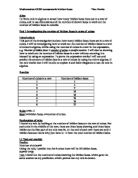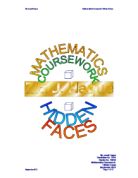I can see that 3n is 36 and then I will minus 2. So 36-2 = 16, which is correct, so I now know that the formula is correct.
Another way of working out the nth term is to use the graph. Using the formula y=m+c. The gradient is 3/1=3 and the line passes the y-axis at –2. So the formula is y=3-2. So the nth term would be 3n-2.
Moving on, I now need to work out how to calculate the number of hidden faces when there are more than one row of cubes, I therefore need to find patterns to find the formulas for different number of rows. So I drew the first three diagrams for each number of rows (below):
From these diagrams I can see a few patterns. I can see that with one row, when another cube is placed at the end another three hidden faces are added. With this information I can work out the rest of the column with one row. I noticed that with two rows when another two cubes are placed at the end then another eight hidden faces are added. With three rows when three cubes are placed at the end then thirteen hidden faces are added. I can now see that the number of hidden faces added each time the length is increased by one, goes up by five for every row.
With this in mind I am able to complete the tables (below):
I decided to show this information in one single table (below):
From this I can see the rest of the formulas. For the second formula I will use the tables to work it out. I can see that the nth term goes up by 8, so it is 8n, then I can see that the last number is –2 the number of rows, which is –4, so the formula is 8n-4. I can now work out the rest of the formulas as the first number goes up by 5n and the second one goes up by –2n.
I decided to show this information on a graph (below):
From looking at all of this information it is possible to make a formula for any amount of rows. By taking the first few formulas, patterns are easily noticed. Firstly, the first number goes up by 5 (3n…, 8n…, 13n…, etc.), this is equal to the number of rows (r) 5-2. Then we can see the second number goes up by –2, which is the same as r-2. So we can see that the formula is (5r-2)n-2r.
Now I am going to work out a formula to work out the amount of hidden faces in cuboids. In order to do this I will look at one example first.
In order to work out the number of hidden faces of this cuboid, I will work out the amount of shown faces and take it away from the total number of faces. The total number of faces is (width height length number of faces per cube) 4256, this equals 240. The number of shown faces is (42) 2 (the front and back) + (52) 2 (both sides) + (45) 1 (only top, bottom is hidden), this adds up to 56. So 240 –56 =184 hidden faces.
Now I will show the above as a formula that will work for all cuboids.
The total amount of faces is (width height length number of faces per cube) WHL6 = 6LWH. The number of visible faces = (2WH) (front and back) + (2LH) (both sides) + (2 WL) (top), this equals 2WH+2LH+WL. So the formula for calculating the number of hidden faces of any cuboid is: 6LWH-(2WH+2LH+WL)
= 6LWH-2WH-2LH-WL.
In order to make sure this is the correct formula, I will check it on another cuboid and see if it works.
H = 3
W = 6
L = 4
I will now work out the number of hidden faces for this cuboid using the formula above. 6LWH-2WH-2LH-WL = 6463-(263)-(243)-(64) = 348 hidden faces. I will now check that 348 is the correct answer by working it out a different way. I counted the visible sides, and then subtracted that from the total amount of faces and I ended up with 348. So from this I can see that the formula is correct.
Y:\svn\trunk\engine\docs\working\acumen6\64067.doc page of







